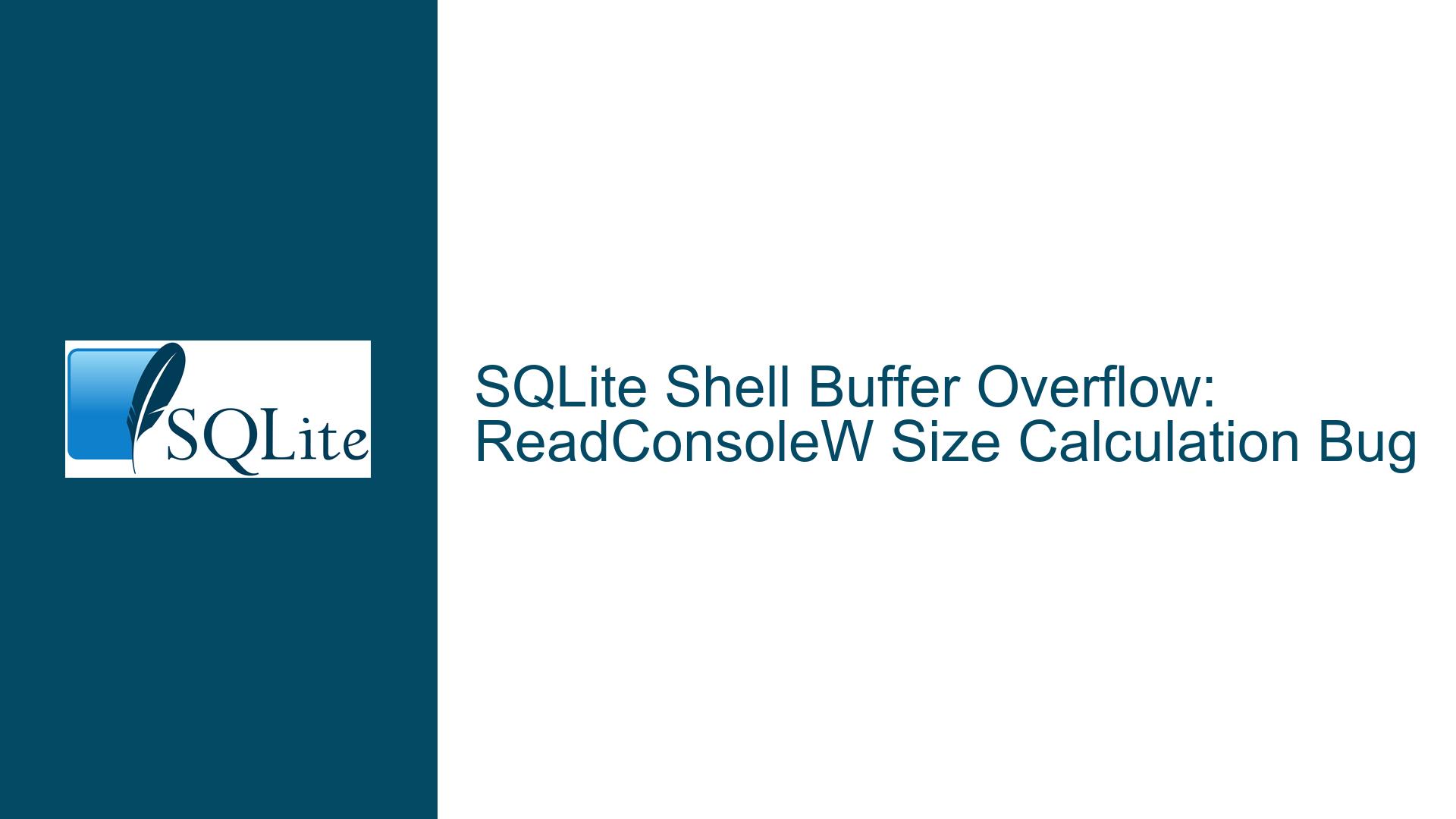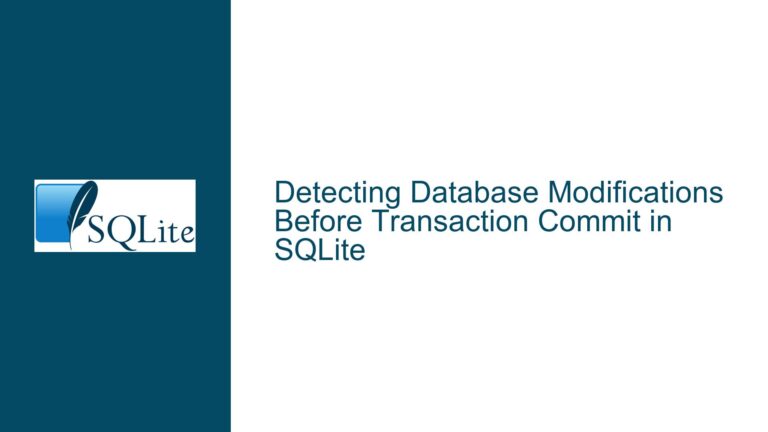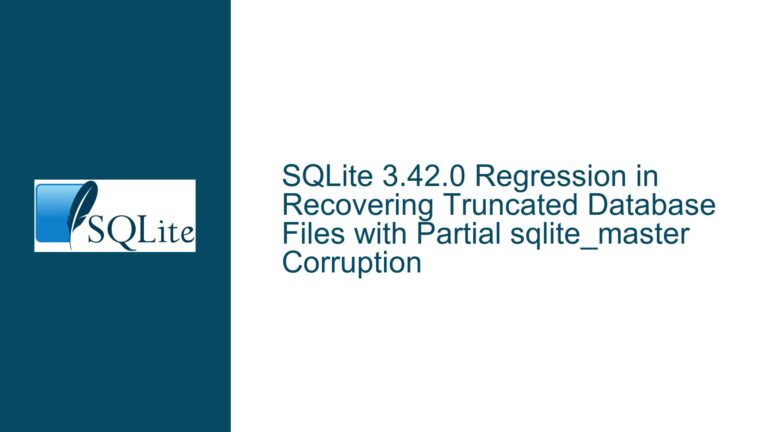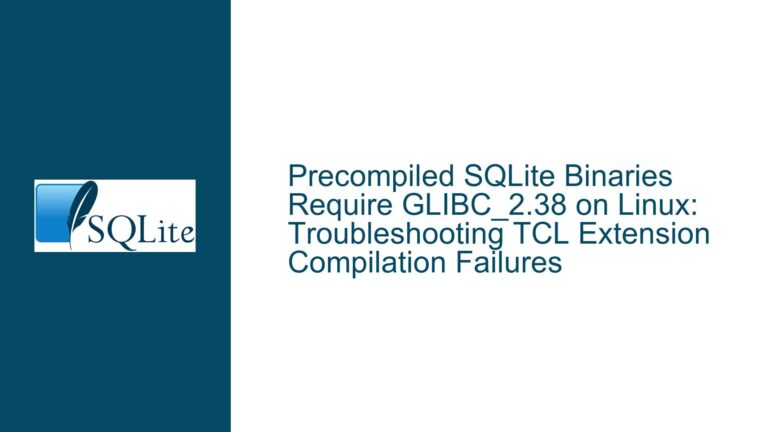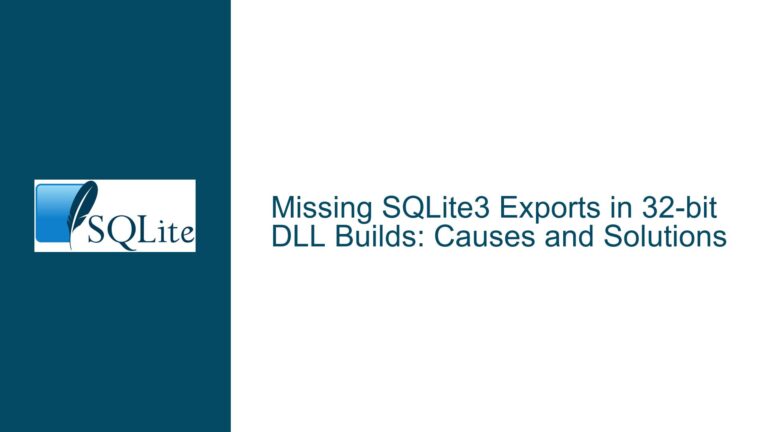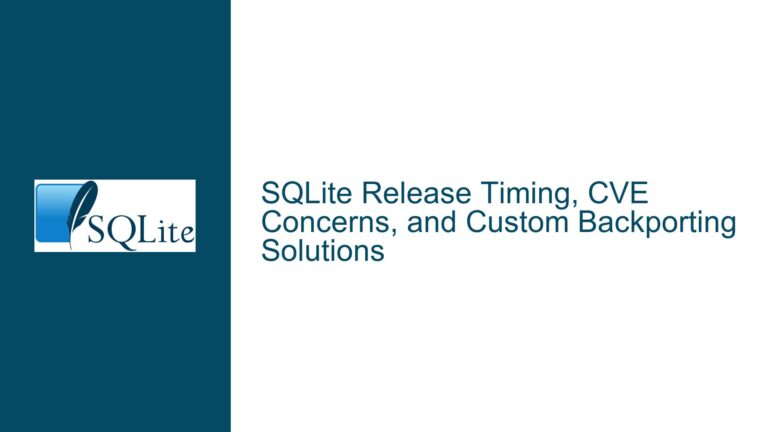SQLite Shell Buffer Overflow: ReadConsoleW Size Calculation Bug
Windows Console Input Buffer Overflow in SQLite 3.48.0 Shell
The SQLite shell application introduced a critical buffer overflow vulnerability in version 3.48.0, specifically affecting the Windows console input handling functionality. The issue manifests in the sqlite3_fgets function when reading Unicode input from the Windows command prompt. The vulnerability occurs due to improper buffer size calculation when using ReadConsoleW to handle UTF-16 character input.
The core problem lies in the memory allocation and buffer handling within the sqlite3_fgets implementation. The function allocates a buffer b1 with size sz*sizeof(wchar_t) to accommodate wide characters, but the subsequent ReadConsoleW call can potentially write beyond the allocated buffer bounds. When ReadConsoleW reads exactly sz bytes of input, the code attempts to append a null terminator at position b1[nRead], which results in a buffer overflow since no space was reserved for the terminator.
This buffer overflow condition becomes particularly problematic because SQLite uses malloc’s guard cookies for memory protection in debug builds. When sqlite3_free is later called on the corrupted buffer, the application crashes due to the invalidated guard cookie. The vulnerability specifically manifests under the following conditions:
- The SQLite shell is compiled without the
SQLITE_USE_STDIO_FOR_CONSOLEdefine - Input is being read from the Windows console
- The input contains non-ASCII characters requiring UTF-16 handling
- The input size matches or exceeds the allocated buffer size
The vulnerability’s impact is heightened by SQLite’s widespread use as an embedded database engine across various platforms and applications. While SQLite is typically praised for its reliability and lightweight nature, this buffer overflow issue represents a significant security concern for applications that rely on the SQLite shell’s console input handling capabilities.
The issue particularly affects developers and applications that:
- Use SQLite shell for interactive database operations on Windows
- Process Unicode input through the command line interface
- Rely on console-based SQLite tools for database management
- Implement custom solutions using SQLite shell components
This buffer overflow vulnerability is especially concerning because SQLite is frequently employed in scenarios where stability and security are paramount, such as embedded systems, mobile applications, and small-scale web projects. The bug’s presence in the shell component, while not affecting the core database engine, still poses risks for administrative and development workflows that depend on the SQLite command-line interface.
Root Causes & Memory Management Concerns
Memory allocation and buffer handling in SQLite’s shell component presents several critical issues that can lead to buffer overflows. The primary concerns stem from how memory is allocated and managed when dealing with wide character input, particularly in Windows environments.
Buffer Size Calculation
The fundamental problem lies in the relationship between allocated memory and actual buffer requirements. When allocating memory for wide characters, the calculation must account for:
- The base character size
- The wide character multiplier
- Space for null termination
- Guard bytes for memory protection
Memory Protection Mechanisms
SQLite employs several memory protection features that can be compromised:
| Protection Type | Purpose | Vulnerability Point |
|---|---|---|
| Guard Cookies | Memory corruption detection | Buffer overflow invalidates cookies |
| Null Terminators | String boundary marking | Improper placement causes overflow |
| Memory Alignment | Access optimization | Misalignment from incorrect sizing |
Platform-Specific Considerations
Windows console input handling introduces additional complexity due to:
The UTF-16 character encoding requires precise buffer calculations to prevent overflow conditions. The Windows console’s ReadConsoleW function behavior differs from standard input methods, requiring special handling of buffer sizes and termination.
Architectural Weaknesses
The core architectural issues manifest in several ways:
- Memory allocation patterns that don’t account for complete buffer requirements
- Insufficient bounds checking before buffer operations
- Inconsistent handling of string termination across different input methods
- Lack of proper buffer size validation before write operations
Technical Impact Factors
The severity of these issues is amplified by:
| Factor | Impact |
|---|---|
| Debug Builds | Crash on guard cookie validation |
| Release Builds | Potential silent corruption |
| Memory Layout | Possible exploitation vectors |
| Input Encoding | UTF-16 size multiplication effects |
Compiler and Environment Dependencies
The manifestation of these issues varies based on:
The presence of stack canaries and other compiler protections. The specific memory layout determined by the build environment. The operating system’s memory management policies.
These underlying causes create a complex web of potential failure points that must be carefully considered when implementing fixes or mitigations. The interaction between Windows-specific console handling and SQLite’s internal memory management creates particularly challenging scenarios for maintaining memory safety.
Memory Management & Buffer Safety Implementation Guide
Immediate Buffer Fix
The most straightforward solution involves modifying the buffer allocation strategy in the ReadConsoleW implementation. Rather than allocating exactly sz*sizeof(wchar_t) bytes, the allocation should include space for the null terminator:
wchar_t *b1 = sqlite3_malloc((sz + 1) * sizeof(wchar_t));
Memory Protection Implementation
Memory protection requires a comprehensive approach focusing on several key areas:
| Protection Layer | Implementation Strategy | Impact |
|---|---|---|
| Guard Pages | Enable memory page protection | Prevents buffer overruns |
| Allocation Tracking | Implement allocation size validation | Detects overflow attempts |
| Boundary Checking | Add pre/post allocation checks | Ensures buffer integrity |
Cache Configuration
Proper cache configuration significantly impacts memory safety:
PRAGMA cache_size = -2000;
PRAGMA page_size = 4096;
PRAGMA mmap_size = 30000000000;
Write-Ahead Logging Setup
Implementing WAL mode enhances both safety and performance:
PRAGMA journal_mode = WAL;
PRAGMA synchronous = NORMAL;
PRAGMA wal_autocheckpoint = 1000;
Memory-Mapped I/O Configuration
Memory mapping configuration requires careful consideration of system resources:
sqlite3_config(SQLITE_CONFIG_PAGECACHE, buffer, size, n);
sqlite3_config(SQLITE_CONFIG_HEAP, heap, heap_size, min_fragment);
Debug Build Protections
For development environments, additional safeguards should be implemented:
| Debug Feature | Purpose | Implementation |
|---|---|---|
| Guard Cookies | Detect overflow | Enable malloc debugging |
| Heap Validation | Verify allocation integrity | Regular heap checks |
| Buffer Monitoring | Track buffer usage | Implement size tracking |
Production Environment Safeguards
Production systems require robust protection mechanisms:
PRAGMA secure_delete = ON;
PRAGMA auto_vacuum = INCREMENTAL;
PRAGMA temp_store = MEMORY;
Unicode Input Handling
Proper Unicode handling requires specific configuration:
SetConsoleOutputCP(CP_UTF8);
SetConsoleCP(CP_UTF8);
Transaction Management
Implementing proper transaction boundaries helps prevent memory issues:
PRAGMA journal_size_limit = 32768;
PRAGMA busy_timeout = 5000;
System Resource Management
Effective resource management requires careful configuration of system parameters:
| Resource | Configuration | Purpose |
|---|---|---|
| Page Cache | Optimize size | Prevent memory exhaustion |
| Memory Map | Configure limits | Control virtual memory |
| File Handles | Set appropriate limits | Manage system resources |
Error Recovery Mechanisms
Implementing robust error recovery requires several components:
sqlite3_config(SQLITE_CONFIG_MEMSTATUS, 1);
sqlite3_config(SQLITE_CONFIG_LOG, error_callback);
Performance Optimization
While maintaining safety, performance can be optimized through:
PRAGMA optimize;
PRAGMA analysis_limit = 1000;
PRAGMA cache_spill = 1048576;
These implementations should be accompanied by regular monitoring and maintenance routines to ensure continued effectiveness and safety. The combination of these measures creates a robust defense against buffer overflows while maintaining system performance and stability.
